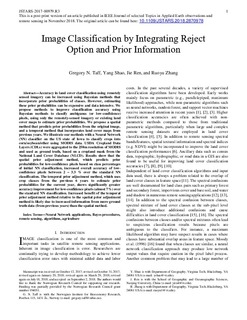| dc.contributor.author | Taff, Gregory | |
| dc.contributor.author | Shao, Yang | |
| dc.contributor.author | Ren, Jie | |
| dc.contributor.author | Zhang, Ruoyu | |
| dc.date.accessioned | 2019-05-15T11:46:22Z | |
| dc.date.available | 2019-05-15T11:46:22Z | |
| dc.date.created | 2018-09-03T11:11:37Z | |
| dc.date.issued | 2018-11-11 | |
| dc.identifier.citation | IEEE Journal of Selected Topics in Applied Earth Observations and Remote Sensing. 2018, 11 (11), 3931-3939. | nb_NO |
| dc.identifier.issn | 1939-1404 | |
| dc.identifier.uri | http://hdl.handle.net/11250/2597688 | |
| dc.description.abstract | The accuracy in land-cover classification using remotely sensed imagery can be increased using Bayesian methods that incorporate prior probabilities of classes. However, estimating these prior probabilities can be expensive and data intensive. We propose methods to improve the classification accuracy using Bayesian methods to classify ambiguous (or low-confidence) pixels, using only the remotely sensed imagery or existing land-cover maps to estimate prior probabilities. We propose a spatial method that predicts prior probabilities from the original image, and a temporal method that incorporates land-cover maps from previous years. We illustrate our methods with a neural network (NN) classifier on the U.S. state of Iowa to classify crops into corn/soybean/other using moderate resolution imaging spectroradiometer (MODIS) data. USDA cropland data layers were aggregated to the 250-m resolution of MODIS and used as ground truth, based on a cropland mask from the National Land Cover Database. Results show that the spatial-prior-adjustment method, which predicts prior probabilities for low-confidence pixels based on class percentages of initial NN classification, increased overall accuracy of low-confidence pixels between 2% and 3.3% over the standard NN classification. The temporal-prior-adjustment method, which uses crop classes from the previous six years to estimate prior probabilities for the current year, shows significantly greater accuracy improvement for low-confidence pixels (almost 7%) over the standard NN classification. Increased benefit of the temporal-prior-adjustment method relative to the spatial-prior-adjustment method is likely due to increased information from more ground truth data (from previous years) than the spatial method. | nb_NO |
| dc.language.iso | eng | nb_NO |
| dc.subject | Agriculture | nb_NO |
| dc.subject | Algorithms | nb_NO |
| dc.subject | Bayes procedures | nb_NO |
| dc.subject | Neutral network (NN) applications | nb_NO |
| dc.subject | Remote sensing | nb_NO |
| dc.title | Image Classification by Integrating Reject Option and Prior Information | nb_NO |
| dc.type | Journal article | nb_NO |
| dc.type | Peer reviewed | nb_NO |
| dc.description.version | acceptedVersion | nb_NO |
| dc.rights.holder | © 2018 IEEE | nb_NO |
| dc.subject.nsi | VDP::Landbruks- og Fiskerifag: 900 | nb_NO |
| dc.source.pagenumber | 3931-3939 | nb_NO |
| dc.source.volume | 11 | nb_NO |
| dc.source.journal | IEEE Journal of Selected Topics in Applied Earth Observations and Remote Sensing | nb_NO |
| dc.source.issue | 11 | nb_NO |
| dc.identifier.doi | 10.1109/JSTARS.2018.2870978 | |
| dc.identifier.cristin | 1606189 | |
| dc.relation.project | Norges forskningsråd: 194051 | nb_NO |
| cristin.unitcode | 7677,5,0,0 | |
| cristin.unitname | Divisjon for kart og statistikk | |
| cristin.ispublished | true | |
| cristin.fulltext | postprint | |
| cristin.qualitycode | 1 | |
